
Thomas Rhett hit the road this summer in support of his fourth studio album, Center Point Road, for his “Very Hot Summer Tour.” With 13 number-one hits in his repertoire, the artist had no problem filling arenas all over North America. We caught up with Fireplay’s Nick Whitehouse, Kelly Sticksel and Brian Vaughan to chat about their production design and the elements they included in this show.
Five years ago, Nick Whitehouse got a call from a tour manager who had an up-and-coming talent who had just seen the Justin Timberlake show he had designed. “He asked me if I would be willing to come and meet Thomas Rhett and just give him some tips on his show,” says Whitehouse. “I got on a flight to Nashville and saw my first country music show. TR was first on the bill, and after his set, we sat on the bus and discussed his show. I was really impressed with him and how he wanted to be better live… five years later, we have designed all his shows and have really grown together, and I feel brought something different to the country music world. When we formed Fireplay he actually became our first client.”
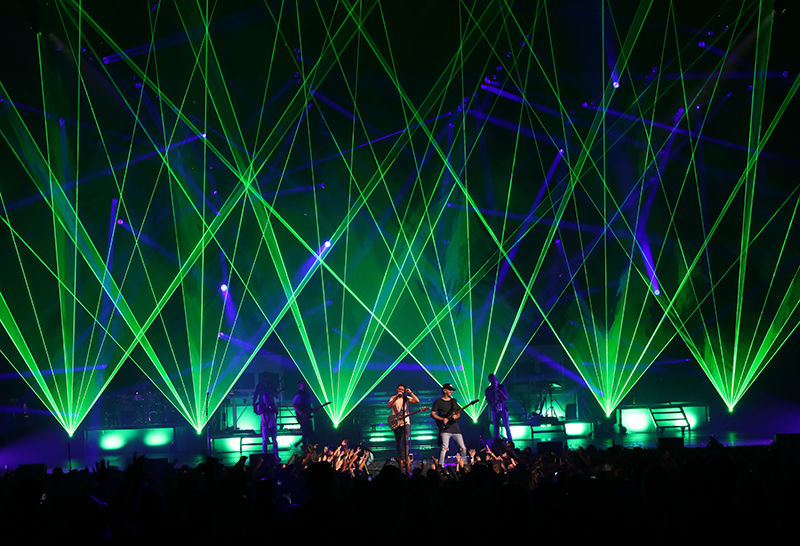
Lighting Excitement
The lighting supplied all the visuals this artist needed to keep the crowd excited during the show, as the stage lacks video elements other than some side projection screens used for I-Mag purposes. There are six trusses. They start as floor trusses and then curve up the back wall to become overhead trusses and fan way out into the audience. These fingers sit in between the backline risers. All six trusses have a 20-foot section that is automated with a Kinesys smart hoist system. A mother grid lives above these end trusses for easier rigging and motion control of these moving truss sections.
These trusses looked curved from left to right at times, but that’s not the case. Whitehouse explains, “It’s the amount of beams and the focus positions which provide these interesting shapes. Very much like a mathematician using lots of straight lines to draw parabolic curves, it’s the illusion that tricks the eye into thinking the truss is bent.” The trusses are all Tyler GT, with the fixtures riding in them. Tyler and Tait teamed up to make custom curved spacer sections to join them together to achieve the curve the design spec’d.
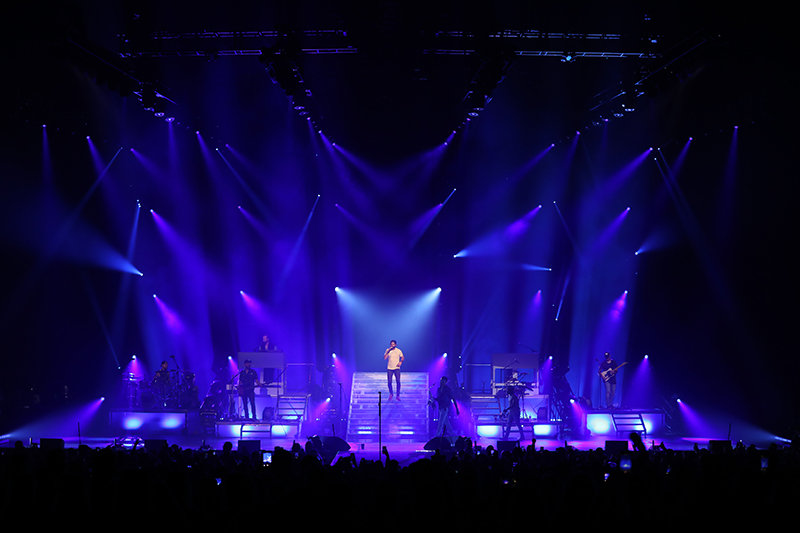
Claypaky Mythos 2 fixtures bore the brunt of the work. Nick wanted to use just one type of fixture and explains his choice. “I wanted one hybrid moving light fixture for this. To get the beam curve effects, we needed a substantial amount of fixtures and were on a pretty tight budget. We needed to get as much out of one fixture as possible. I am really impressed with how the Mythos has delivered this for us.”
Along with the 138 Claypaky Mythos 2 fixtures, the tour rig included 84 Acme Dotline 360 tilting battens. Nick explains how they ended up in the rig. “This tour was put out to bid, with several lighting companies offering choices in gear. Upstaging has looked after Thomas Rhett for us the last four years, and they offered us choices. This decision was budget-driven — we initially had a fixed LED line here, and as we progressed with the design, John Bahnick at Upstaging sent over the cut sheet and told us they were considering investing in this product, and ‘would we be okay using them?’ They performed really well for us and were more impressive then I was expecting. Upstaging gave us a fantastic deal on the lights and video along with amazing support. They really go above and beyond for TR.”

A Follow-Me system played a big role as well, with Claypaky Scenius Unicos used as key lights. Nick explains, “We have been using the Unicos and Follow-Me system for quite some time and even had some custom software developed on it for Fireplay. It’s a great system, and we have found the Unico to be an incredibly good-looking key light. There are sets of these in the farthest downstage sections of the fingers to provide key lighting. We like to play with silhouette and colors on the band members in this show, then at other times light them fully.”
Associate designer Brian Vaughan chimes in. “A large part of having a successful Follow-Me show is having a super accurate light. The Unico is a very accurate fixture which, in turn, makes Follow Me that much more accurate. On [Justin] Timberlake’s tour, we had explored some other fixtures with this system, but always came back to the Unico for its speed, output and reliability.”
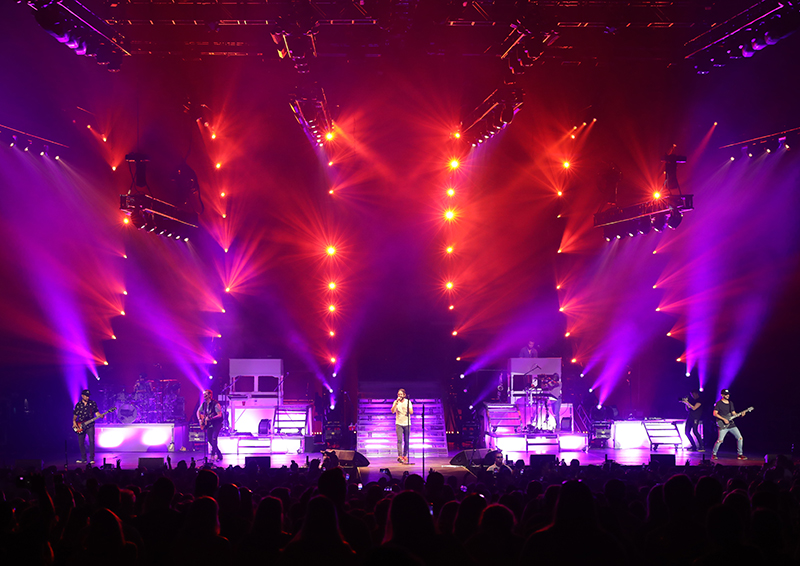
Programming the Looks
Brian Vaughan was TR’s lighting director for a couple of years and now works for Fireplay. Alec Takahashi was brought in to direct Rhett’s tour a couple years back and aids in the programming. Nick expands on this. “Alec, Brian and I all programmed this show together. It’s a massive lighting rig and a very bold move to ditch all video content. This team really pushed each other. Alec is a fantastic LD and programmer; we’re really happy he’s on this show and are very comfortable that it’s in his hands.”
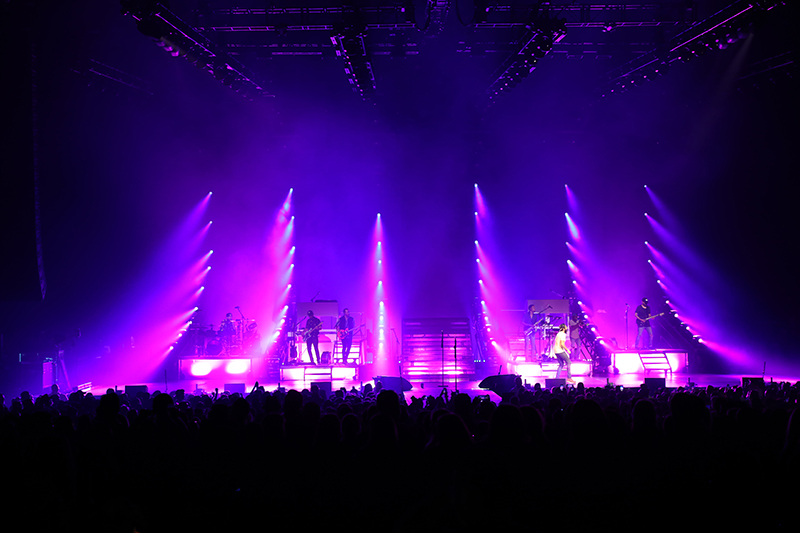
Tait provided the set, which consisted of a bunch of risers with step units connecting them all. “The band members like to come downstage and play with TR a lot, and he likes to go up to them as well, so front steps made sense for this set.” explains Whitehouse. “In the middle, we have a large ramp the artist uses to make his entrance. We installed a toaster at the top of the ramp for the artist’s entrance via this hidden lift. He’s been known to get 10 feet of air when he pops out of it.” Solaris Flares are used to backlight the front panels of the risers while Chauvet Strike 4 fixtures were used to illuminate the crowd.
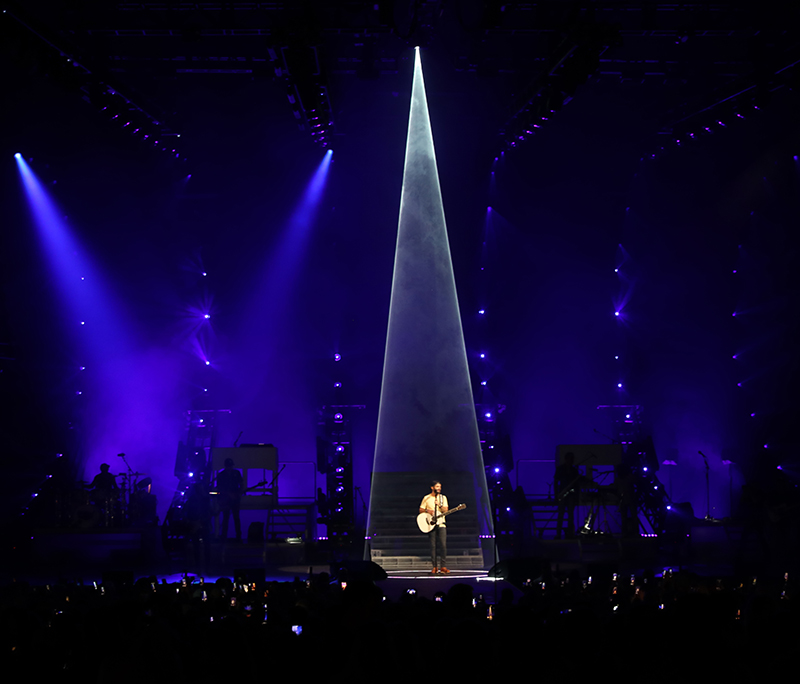
Tait also provided a center thrust along with a small B stage by front of house that the artist uses to get intimate with the crowd. For a nice, quiet atmosphere, a tungsten look was preferred. Vaughan explains, “We have pantographs with Robe Patts that we lower down for this intimate moment. The Robe Patts add a ton of mood to a broken down acoustic set, where TR is in the middle of the crowd, just jamming out with a few of the band guys. When he’s on that stage, he is truly owning that moment. We needed something that had a ton of attitude in the appearance of the fixture, but not so much to where it takes away from TR’s moment. The Robe Patts give us that “Old School” tungsten look but with new age technology.”
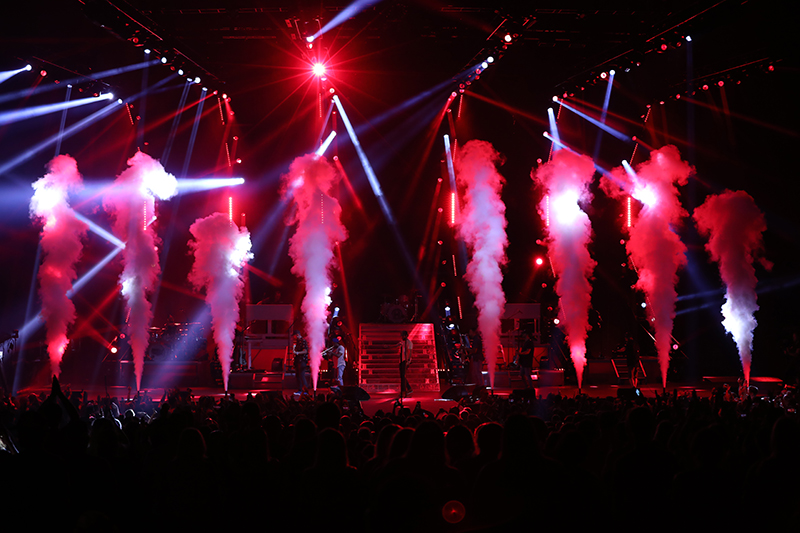
SFX: The Full Shebang
This year’s tour incorporated plenty of special effects (SFX). Fireplay’s Kelly Sticksel is an expert in that field and has been looking after this artist along with Pyrotecnico since he and Nick started working together. “TR has wanted special effects for as long as I’ve known him,” Sticksel says. “This was the year that it all came together. He got his lasers, he got his cryo, he got his pyro and he got his streamers (which he races down the catwalk every night as Alec cues the sequence). TR was very involved when it came to placing the effects and the type of effects he envisioned. This is a guy who is a perfectionist in his music — and what he wants on stage. It’s such a blast working with him.”
Sticksel explains how he approached using special effects on this tour. “When it comes to creating special effects for Nashville artists, I tend to follow Nick’s strategy and find ‘reason’ in everything I design. Frankly, this bucks tradition a bit in the country world — ‘If I’m paying for it, I’m going to use it as often as I can.’ I tend to focus on using the FX budgets in ways that further the story of the show — not just check gags off a list. I find lyric references in the music that trigger imagery of effects — or just find riffs that can be visualized in an effect. Like Nick, I’m also very sensitive to the overuse of my tools. We might find a good balance of putting effects in two or three songs in a set list. Rarely do we punctuate more than that — and there must be a compelling reason if we do. Of course we absolutely listen to and collaborate with the artist, but most of the time they are seeking our guidance in this area.”
As for gear, the cryo jets were custom models that Pyrotecnico manufactures. Additionally, Pyrotecnico creates their own DMX control modules for each jet, making them remarkably reliable. There were also gerbs that shot downward in the show. Kelly expands, “We used traditional unchoked silver gerbs from Next FX. I specify these as they provide the best punctuation. I also do this to mitigate fallout since TR and his band love to dance on stage.” Air bursts, 25-foot falling stars and Stadium Shot streamers add to the mix.
Lasers play a major role in the show, with six 20-watt Kvant Spectrum models set on the floor and one more flown directly overhead that can be used a downlight on the artist. Sticksel expands on their use. “I consider the Kvant lasers to be the workhorse lasers of the sfx industry. Pyrotecnico has a fleet of these. I requested Will Kent to come in and program the lasers as we make a really good team. He gets my crazy requests and transforms them into solid laser cues.”
Mounted in the center and perpendicular to each finger is a laser bar. “We spec’d Arctos laser bars. I wanted something to use sparingly that didn’t look like traditional scanned laser effects. In Alec’ and Brian’s hands, they made the bars dance directly from the grandMA. It kept things fresh in the laser world,” Sticksel says.
“With regard to SFX, Rocco [Vitale, with Pyrotecnico] has been taking care of TR for various small gags for several years — as long as I’ve been with TR. They’ve always done a fine job and were sensitive to budgets. This was, by far, the largest contingent of SFX that TR has utilized. I think they’re a big and meaningful part of the show and I’ve very proud of their team.”

Thomas Rhett “Very Hot Summer” Tour
Crew
- Production Design: Fireplay (Nick Whitehouse, Kelly Sticksel, Josh Zangen, Brian Vaughan)
- SFX Designer: Kelly Sticksel
- Lighting Director: Alec Takahashi
- Lighting Programmers: Brian Vaughan; Alec Takahashi; Nick Whitehouse
- Lighting Co: Upstaging/John Bahnick
- Lighting Crew Chief: Greg Ogne
- Lighting Techs: Julie Cox; Ryder Deas; Keaton Lovell; Zach Schwandt; Kile McClure; Nick Schlosser
- Tour Manager: Mike Finn
- Production Manager: Kevin Twist
- Stage Manager: Morgan Burton
- Lasers/SFX/Confetti: Pyrotecnico/Rocco Vitale
- Laser Tech: Patrick Konkel
- Pyro Tech: Sean Moore
Staging: Tait/Aaron Siebert, Shannon Nickerson - Rigger: Clay Christian
- Carpenters: Patrick Maloney; Jonah Fickel; Andre Wilford; Anthony Wilford
- Automation Tech: Kile McClure
- Follow-Me Tech: Zach Schwandt
- Video Co: Upstaging
- Video Crew Chief: Ricky Krohne
- Video Director: Brian “Sweet Pea” Carico
- Video Crew: Anthony Morgan, Russ Spann
- Trucking: On Tour Logistics/Scott Ulmer
Gear
- 2 grandMA2 Full consoles
- 138 Claypaky Mythos 2
- 84 Acme Dotline 360
- 28 TMB Solaris Flare Q+
- 14 Vari-Lite VL3000 Spots
- 18 Chauvet Strike 4 Moles
- 12 Claypaky Scenius Unicos
- 8 Color Kinetics ColorBlast TRX
- 1 Follow-Me system (2 cams, 4 Mac Minis, 1 Main, 1 PSN, 2 backups
- 2 MDG theOne units
- 6 Luminex Ethernet DMX8 Mk II Nodes
- 2 Luminex Gigacore 16Xt managed switches
- 4 Luminex Gigacore 26l managed switches
- 2 Brainstorm SR-112 Timecode Reader
- 1 Fellow Stagg EKG
- 1 Kinesys Vector system: 12 1000kg Liftkets, 3 500kg Liftkets, plus moving pantographs
- 1 Video package w/ 3 Barco 30K projectors, 4 Sony 1700HTC cameras, 2 Canon 80x lenses, 1 Blackmagic Design Atem 2 M/E switcher
- 1 Laser package w/7 Kvant 20W lasers, 10 Arctos Laser Beam Bars
- 1 Pyro package w/25 Gerbs, 25’ Fall stars, 15’ Air bursts, 8 Cryo Jets, 16 Stadium Shot confetti units.


